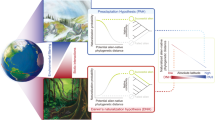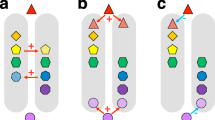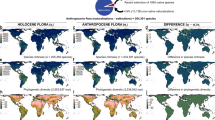Abstract
Human activities are causing global biotic redistribution, translocating species and providing them with opportunities to establish populations beyond their native ranges. Species originating from certain global regions, however, are disproportionately represented among naturalized aliens. The evolutionary imbalance hypothesis posits that differences in absolute fitness among biogeographic divisions determine outcomes when biotas mix. Here, we compile data from native and alien distributions for nearly the entire global seed plant flora and find that biogeographic conditions predicted to drive evolutionary imbalance act alongside climate and anthropogenic factors to shape flows of successful aliens among regional biotas. Successful aliens tend to originate from large, biodiverse regions that support abundant populations and where species evolve against a diverse backdrop of competitors and enemies. We also reveal that these same native distribution characteristics are shared among the plants that humans select for cultivation and economic use. In addition to influencing species’ innate potentials as invaders, we therefore suggest that evolutionary imbalance shapes plants’ relationships with humans, impacting which species are translocated beyond their native distributions.
This is a preview of subscription content, access via your institution
Access options
Access Nature and 54 other Nature Portfolio journals
Get Nature+, our best-value online-access subscription
$29.99 / 30 days
cancel any time
Subscribe to this journal
Receive 12 digital issues and online access to articles
$119.00 per year
only $9.92 per issue
Buy this article
- Purchase on Springer Link
- Instant access to full article PDF
Prices may be subject to local taxes which are calculated during checkout




Similar content being viewed by others
Code availability
R code used to perform analyses can be found in Supplementary Code 1, available through https://doi.org/10.6084/m9.figshare.21512145 (ref. 74).
References
Richardson, D. M. et al. Naturalization and invasion of alien plants: concepts and definitions. Divers. Distrib. 6, 93–107 (2000).
Darwin, C. On the Origin of Species (John Murray, 1859).
van Kleunen, M. et al. Global exchange and accumulation of non-native plants. Nature 525, 100–103 (2015).
van Kleunen, M. et al. Economic use of plants is key to their naturalization success. Nat. Commun. 11, 3201 (2020).
Dyer, E. E. et al. The global distribution and drivers of alien bird species richness. PLoS Biol. 15, e2000942 (2017).
Dyer, E. E., Redding, D. W. & Blackburn, T. M. The global avian invasions atlas, a database of alien bird distributions worldwide. Sci. Data 4, 170041 (2017).
van Kleunen, M. et al. The Global Naturalized Alien Flora (GloNAF) database. Ecology 100, e02542 (2019).
Vermeij, G. J. When biotas meet: understanding biotic interchange. Science 253, 1099–1104 (1991).
Vermeij, G. in Species Invasions: Insights into Ecology, Evolution, and Biogeography (eds Sax, D. F. et al.) 315–340 (Sinauer, 2005).
Fridley, J. D. & Sax, D. F. The imbalance of nature: revisiting a Darwinian framework for invasion biology. Glob. Ecol. Biogeogr. 23, 1157–1166 (2014).
Leimu, R., Mutikainen, P., Koricheva, J. & Fischer, M. How general are positive relationships between plant population size, fitness and genetic variation? J. Ecol. 94, 942–952 (2006).
Tilman, D. Diversification, biotic interchange, and the universal trade-off hypothesis. Am. Nat. 178, 355–371 (2011).
Dobzhansky, T. Evolution in the tropics. Am. Sci. 38, 209–221 (1950).
MacArthur, R. H. Geographical Ecology: Patterns in the Distribution of Species (Princeton Univ. Press, 1972).
Cody, M. L. & Mooney, H. A. Convergence versus nonconvergence in Mediterranean-climate ecosystems. Annu. Rev. Ecol. Syst. 9, 265–321 (1978).
Lenski, R. E., Rose, M. R., Simpson, S. C. & Tadler, S. C. Long-term experimental evolution in Escherichia coli. I. Adaptation and divergence during 2,000 generations. Am. Nat. 138, 1315–1341 (1991).
Leigh, E. G. Jr, Vermeij, G. J. & Wikelski, M. What do human economies, large islands and forest fragments reveal about the factors limiting ecosystem evolution? J. Evolut. Biol. 22, 1–12 (2009).
Fridley, J. D., Jo, I., Hulme, P. E. & Duncan, R. P. A habitat-based assessment of the role of competition in plant invasions. J. Ecol. 109, 1263–1274 (2021).
World Checklist of Vascular Plants, Version 2.0 (Royal Botanic Gardens Kew, 2022); http://wcvp.science.kew.org/
Haeuser, E. et al. European ornamental garden flora as an invasion debt under climate change. J. Appl. Ecol. 55, 2386–2395 (2018).
Liu, C., Wolter, C., Xian, W. & Jeschke, J. M. Most invasive species largely conserve their climatic niche. Proc. Natl Acad. Sci. USA 117, 23643–23651 (2020).
Seebens, H. et al. Global trade will accelerate plant invasions in emerging economies under climate change. Glob. Change Biol. 21, 4128–4140 (2015).
Bertelsmeier, C., Ollier, S., Liebhold, A. & Keller, L. Recent human history governs global ant invasion dynamics. Nat. Ecol. Evol. 1, 0184 (2017).
di Castri, F. in Biological Invasions: A Global Perspective (eds Drake, J.A. et al.) 1–30 (Wiley, 1989).
MacDougall, A. S. & Turkington, R. Are invasive species the drivers or passengers of change in degraded ecosystems? Ecology 86, 42–55 (2005).
Brummitt, R. World Geographical Scheme for Recording Plant Distributions, Edition 2 (Hunt Institute for Botanical Documentation, Carnegie Mellon University, 2001); http://www.tdwg.org/standards/109
Global Compositae Database (Compositae Working Group, 2022); https://www.compositae.org/
The IUCN Red List of Threatened Species (IUCN, 2022); https://www.iucnredlist.org
USDA-ARS Germplasm Resources Information Network (GRIN) (United States Department of Agriculture, 2022); https://www.ars-grin.gov
Plants of the World Online (Royal Botanic Gardens Kew, 2022); http://www.plantsoftheworldonline.org/
Brown, S. C., Wigley, T. M. L., Otto-Bliesner, B. L. & Fordham, D. A. StableClim, continuous projections of climate stability from 21000 bp to 2100 ce at multiple spatial scales. Sci. Data 7, 335 (2020).
Ehlers, J., Gibbard, P. L. & Hughes, P. D. Quaternary Glaciations - Extent and Chronology: A Closer Look (Elsevier, 2011).
Yang, Q. et al. The global loss of floristic uniqueness. Nat. Commun. 12, 7290 (2021).
Lenzner, B. et al. Naturalized alien floras still carry the legacy of European colonialism. Nat. Ecol. Evol. 6, 1723–1732 (2022).
Klein Goldewijk, K., Beusen, A., Doelman, J. & Stehfest, E. Anthropogenic land use estimates for the Holocene – HYDE 3.2. Earth Syst. Sci. Data 9, 927–953 (2017).
Diamond, J. M. Guns, Germs, and Steel: The Fates of Human Societies (W.W. Norton, 1997).
Diamond, J. & Bellwood, P. Farmers and their languages: the first expansions. Science 300, 597–603 (2003).
Vilela, B. et al. Cultural transmission and ecological opportunity jointly shaped the spread of human agriculture. Evol. Hum. Sci. 2, E53 (2020).
Balick, M. J. & Cox, P. A. Plants, People, and Culture: The Science of Ethnobotany (Garland Science, 2020).
Vavilov, N. I., Vavylov, M. I. & Dorofeev, V. F. Origin and Geography of Cultivated Plants (Cambridge Univ. Press, 1992).
Phillips, O. & Gentry, A. H. The useful plants of Tambopata, Peru: II. Additional hypothesis testing in quantitative ethnobotany. Econ. Bot. 47, 33–43 (1993).
Gaoue, O. G. et al. Theories and major hypotheses in ethnobotany. Econ. Bot. 71, 269–287 (2017).
Milla, R. et al. Phylogenetic patterns and phenotypic profiles of the species of plants and mammals farmed for food. Nat. Ecol. Evol. 2, 1808–1817 (2018).
Enquist, B. J. et al. The commonness of rarity: global and future distribution of rarity across land plants. Sci. Adv. 5, eaaz0414 (2019).
Pyšek, P. et al. The global invasion success of central European plants is related to distribution characteristics in their native range and species traits. Divers. Distrib. 15, 891–903 (2009).
Fristoe, T. S. et al. Dimensions of invasiveness: links between local abundance, geographic range size, and habitat breadth in Europe’s alien and native floras. Proc. Natl Acad. Sci USA 118, e2021173118 (2021).
Sheth, S. N. & Angert, A. L. The evolution of environmental tolerance and range size: a comparison of geographically restricted and widespread Mimulus. Evolution 68, 2917–2931 (2014).
Pyšek, P. et al. Naturalization of central European plants in North America: species traits, habitats, propagule pressure, residence time. Ecology 96, 762–774 (2015).
Hulme, P. E. Trade, transport and trouble: managing invasive species pathways in an era of globalization. J. Appl. Ecol. 46, 10–18 (2009).
Fristoe, T. S., Iwaniuk, A. N. & Botero, C. A. Big brains stabilize populations and facilitate colonization of variable habitats in birds. Nat. Ecol. Evol. 1, 1706–1715 (2017).
Sunday, J. M., Bates, A. E. & Dulvy, N. K. Global analysis of thermal tolerance and latitude in ectotherms. Proc. R. Soc. B 278, 1823–1830 (2011).
Khaliq, I., Hof, C., Prinzinger, R., Böhning-Gaese, K. & Pfenninger, M. Global variation in thermal tolerances and vulnerability of endotherms to climate change. Proc. R. Soc. B 281, 20141097 (2014).
Svenning, J.-C., Eiserhardt, W. L., Normand, S., Ordonez, A. & Sandel, B. The influence of paleoclimate on present-day patterns in biodiversity and ecosystems. Annu. Rev. Ecol. Evol. Syst. 46, 551–572 (2015).
Seebens, H. et al. Projecting the continental accumulation of alien species through to 2050. Glob. Change Biol. 27, 970–982 (2021).
Preston, C. D., Pearman, D. A. & Hall, A. R. Archaeophytes in Britain. Bot. J. Linn. Soc. 145, 257–294 (2004).
Ecseri, K. & Honfi, P. Comparison of European archaeophyte lists in the light of distribution data. Not. Bot. Horti Agrobot. Cluj Napoca 48, 480–491 (2020).
van Kleunen, M., Bossdorf, O. & Dawson, W. The ecology and evolution of alien plants. Annu. Rev. Ecol. Evol. Syst. 49, 25–47 (2018).
Lenzner, B. et al. Role of diversification rates and evolutionary history as a driver of plant naturalization success. N. Phytol. 229, 2998–3008 (2021).
Pyšek, P. et al. Naturalized alien flora of the world. Preslia 89, 203–274 (2017).
Lonsdale, W. M. Global patterns of plant invasions and the concept of invasibility. Ecology 80, 1522–1536 (1999).
Faith, D. P. Conservation evaluation and phylogenetic diversity. Biol. Conserv. 61, 1–10 (1992).
Smith, S. A. & Brown, J. W. Constructing a broadly inclusive seed plant phylogeny. Am. J. Bot. 105, 302–314 (2018).
Dengler, J. Which function describes the species–area relationship best? A review and empirical evaluation. J. Biogeogr. 36, 728–744 (2009).
Diazgranados, M. et al. World Checklist of Useful Plant Species (Knowledge Network for Biocomplexity, 2020); https://doi.org/10.5063/F1CV4G34
Fouquin, M. & Hugot, J. Two Centuries of Bilateral Trade and Gravity Data: 1827–2014 (CEPII, 2016).
Fick, S. E. & Hijmans, R. J. WorldClim 2: new 1-km spatial resolution climate surfaces for global land areas. Int. J. Climatol. 37, 4302–4315 (2017).
Broennimann, O. et al. Distance to native climatic niche margins explains establishment success of alien mammals. Nat. Commun. 12, 2353 (2021).
R: A Language and Environment for Statistical Computing (R Development Core Team, 2022).
Dormann, C. F. et al. Collinearity: a review of methods to deal with it and a simulation study evaluating their performance. Ecography 36, 27–46 (2013).
Pinheiro, J., Bates, D. & R Core Team nlme: Linear and Nonlinear Mixed Effects Models http://CRAN.R-project.org/package=nlme (2023).
Tung Ho, L. S. & Ané, C. A linear-time algorithm for Gaussian and non-Gaussian trait evolution models. Syst. Biol. 63, 397–408 (2014).
Hilbe, J. M. Logistic Regression Models (CRC Press, 2009).
Hartig, F. DHARMa: Residual Diagnostics for HierARchical Models http://florianhartig.github.io/DHARMa/ (2022).
Fristoe, T. S. et al. Evolutionary imbalance, human history, and the global biogeography of alien plants. Figshare https://doi.org/10.6084/m9.figshare.21512145 (2023).
Acknowledgements
M.v.K. and N.L.K. thank the German Research Foundation DFG for funding (grants 264740629 and 432253815 to M.v.K.). F.E. appreciates funding by the Austrian Science Foundation FWF (grant no. I 5825-B). P.P. and J.P. were supported by EXPRO grant no. 19-28807X (Czech Science Foundation) and long-term research development project RVO 67985939 (Czech Academy of Sciences). J.-M.D.-D. is an independent ecologist.
Author information
Authors and Affiliations
Contributions
T.S.F. and J.B. conceived and designed the study with input from N.L.K., Q.Y., Z.Z. and M.v.K. T.S.F. and J.B. analysed the data. T.S.F. and J.B. wrote the initial draft with input from M.v.K. T.S.F., J.B., N.L.K., Q.Y., Z.Z., W.D., F.E., H.K., J.P., P.P., P. Weigelt, J.-M.D.-D., A.N.S., P. Wasowicz, K.B.W. and M.v.K. contributed data and to subsequent manuscript revisions.
Corresponding author
Ethics declarations
Competing interests
The authors declare no competing interests.
Peer review
Peer review information
Nature Ecology & Evolution thanks Jason Fridley and the other, anonymous, reviewer(s) for their contribution to the peer review of this work. Peer reviewer reports are available.
Additional information
Publisher’s note Springer Nature remains neutral with regard to jurisdictional claims in published maps and institutional affiliations.
Extended data
Extended Data Fig. 1 Drivers of regional naturalization success among biogeographic syndromes (n = 6061 biogeographic syndrome x recipient region comparisons).
Partial residual plots from linear mixed model predicting regional naturalization success among biogeographic syndromes (full results Extended Data Table 4). In the bottom panels, main contributors to a given principal component (loading > 0.50) are listed along the x-axes with the length and direction of arrows indicating the value and sign of the variable loading (see Extended Data Table 3; ‘BGReg’ indicates that PCs for the regional analysis were derived using data for biogeographic syndromes, but not including climate suitability or territorial links). Variables associated with the evolutionary imbalance hypothesis are colored green (Precip. Var. = precipitation variability), anthropogenic variables purple, and climatic suitability in pink. Shaded bands indicate 95% confidence bands.
Supplementary information
Supplementary Information
Supplementary Figs. 1–4, and descriptions for Supplementary Data 1–7 and Supplementary Code 1.
Supplementary Data 1
Table describing matching between GloNAF and TDWG3 regions in .csv format.
Supplementary Data 2
Data for TDWG3 regions, including information for matching to country level data (columns ‘Country1’ to ‘Country6’) in .csv format.
Supplementary Data 3
Data for biogeographic syndromes in .csv format.
Supplementary Data 4
Data for analysis of regional naturalization success in .csv format.
Supplementary Data 5
Species-level data in .csv format.
Supplementary Data 6
Results from single predictor models in .xlsx format.
Supplementary Data 7
Phylogeny used for phylogenetic analyses in Newick (.txt) format.
Supplementary Code 1
R code for reproducing analyses.
Rights and permissions
Springer Nature or its licensor (e.g. a society or other partner) holds exclusive rights to this article under a publishing agreement with the author(s) or other rightsholder(s); author self-archiving of the accepted manuscript version of this article is solely governed by the terms of such publishing agreement and applicable law.
About this article
Cite this article
Fristoe, T.S., Bleilevens, J., Kinlock, N.L. et al. Evolutionary imbalance, climate and human history jointly shape the global biogeography of alien plants. Nat Ecol Evol 7, 1633–1644 (2023). https://doi.org/10.1038/s41559-023-02172-z
Received:
Accepted:
Published:
Issue Date:
DOI: https://doi.org/10.1038/s41559-023-02172-z
This article is cited by
-
Origins of successful invasions
Nature Ecology & Evolution (2023)



